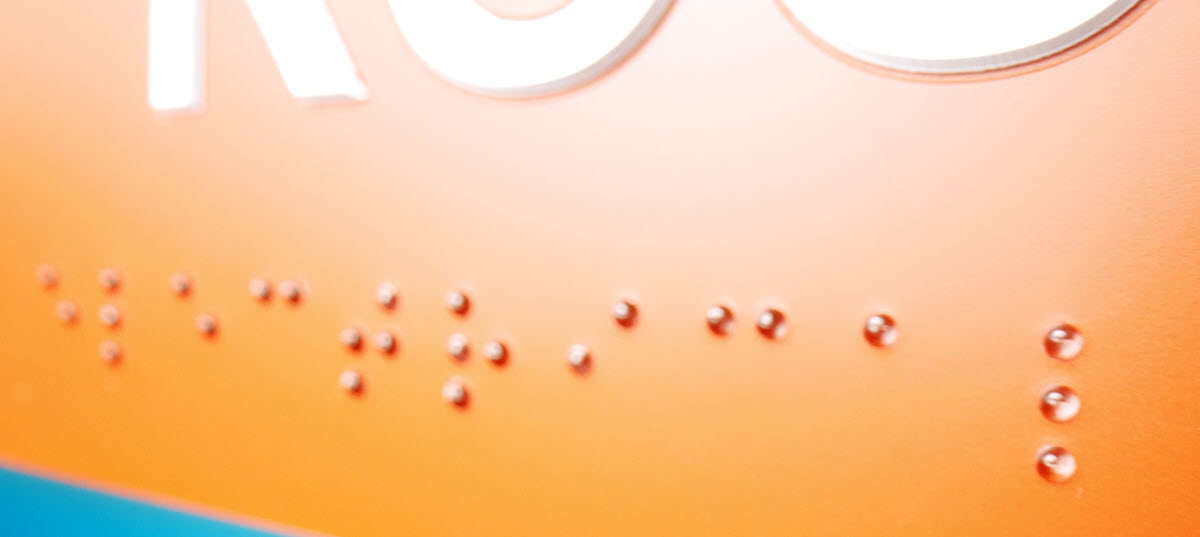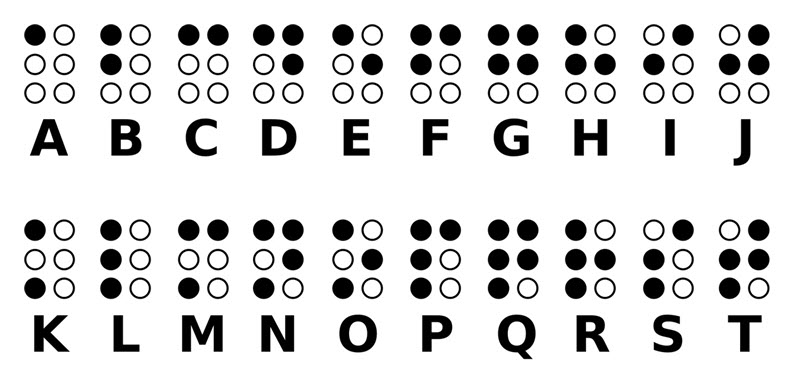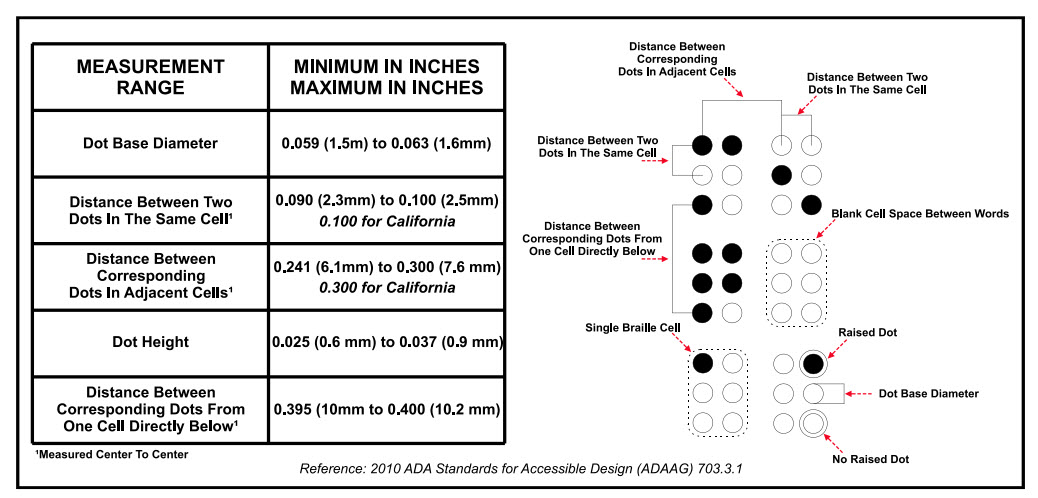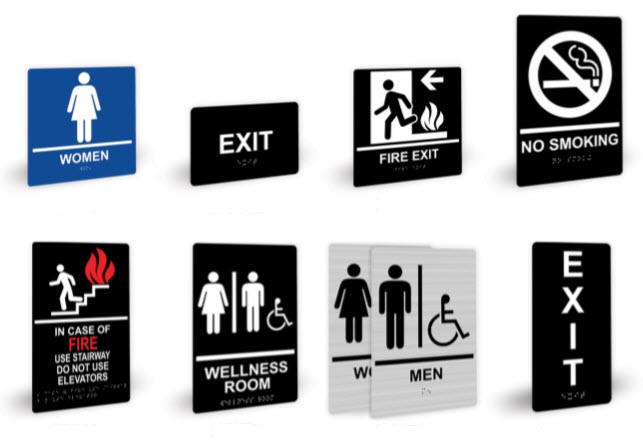
What Every Business Should Know About Braille Signs

As a business owner, you know that it’s essential to change with the times. Not only with the products or services you offer, but your operating space as well. Today, having an inclusive business space is more important than ever, and you’ve done your best to do just that. You have plenty of handicapped parking spaces. You have ramps for wheelchair accessibility and always welcome service animals. But what about your signage?
To aid the visually impaired, the Americans with Disabilities Act (ADA) requires that all public spaces, including businesses, have braille signs with raised tactile letters to mark permanent rooms and spaces. So what does that mean for your business?
What is Braille?
Before we go any further, let’s clarify this first. Braille is a system of raised dots that allows visually impaired people to read using their sense of touch. It was first developed by a young man named Louis Braille in the early 1800s. Braille was blinded at a young age and was determined to develop a method of writing for the visually impaired. His system came to the United States in 1860 and continued to spread until it became accepted worldwide.

Part of the braille alphabet used on ADA braille signs.
Today, braille signs are an essential tool for accessibility to provide important information to visually impaired individuals. The ADA mandates the use of braille signs in certain public areas to ensure people with visual impairment can navigate buildings and understand their surroundings.
The use of braille signs has become increasingly important as the population ages, and the number of individuals with visual impairments continues to grow. According to the National Federation of the Blind, there are an estimated 7.6 million visually impaired people in the United States alone, and this number is expected to double by 2030. As such, braille signage is an essential component of accessibility. Businesses must ensure that visually impaired individuals have equal access to their public spaces.
What is the Americans with Disabilities Act?
The Americans with Disabilities Act was passed by the United States Government in 1990 to protect disabled individuals’ rights in all public spaces. It’s goal is to help provide, “equal opportunity for individuals with disabilities in public accommodations, employment, transportation, state and local government services, and telecommunications.” One of the facets of this regulation is that businesses with publicly available spaces are required to have ADA-compliant braille signs.
What are ADA-Compliant Signs?
The ADA Standards for Accessible Design, published by the Department of Justice, requires that signs marking permanent rooms and spaces must have raised characters and braille. The California Title 24 standard further requires braille signs for exits, floor identification, means of egress and areas of refuge. Directional and information signs are not required to have braille.
There are many regulations governing what makes a braille sign ADA compliant. For one, the design and layout of the braille dots must meet strict specifications:

The braille system uses domed dots specifically arranged in cells to represent letters or words.
Here are some of the other braille sign requirements your business should know:
- The sign must use raised characters that are uppercase, sans serif and free of oblique, script or italic characters.
- Raised characters are required to be raised a minimum of 1/32 inch from the background.
- The height of raised characters should be between 5/8 inch and 2 inches.
- Text must be accompanied by Grade 2 braille dots positioned directly below the corresponding text.
- Braille must be separated a minimum of 3/8 inch from raised text and other raised objects.
- Braille dots are to be domed or rounded, not flat or squared.
- The sign must have a non-glare finish.
- The signs should use high-contrasting colors to make them easy to read, such as white letters on black or dark blue background or black lettering on white background.
- The lettering for tactile signs must be positioned between 48 and 60 inches off the floor.
- Signs marking permanent rooms should be placed adjacent to the door leading to the
room.
Why Braille Signage Matters for Your Business
According to the CDC, one of every four Americans lives with some sort of disability. That’s 61 million people. By adding ADA braille signs, you’re ensuring the safety of any guests who may have a disability, whether you can see it or not. This also gives your business a feeling of inclusiveness and welcome that makes you look good. It shows that you truly value your customers, employees, and guests.

Examples of braille signs commonly found in businesses and public places.
It’s not just about doing the right thing for those with disabilities, it’s also about protecting your business. If your business has over 15 employees, the ADA regulations for signage apply and that means you need to follow them or you could face:
- Fines of up to $75,000 for the first offense and $150,000 for subsequent offenses
- Potential lawsuits from anyone who gets hurt or even inconvenienced because your signage is not up to code
The good news is that it’s a lot easier to make your business ADA compliant than it is to handle a major fine or lawsuit. Complete an audit of your business to see where you need braille signs. Once you have your list, it’s as easy as finding your braille signs here, ordering, and installing at the proper height.
Braille signs are an essential tool for accessibility, and the ADA’s standards for Braille signs have helped to ensure that visually impaired individuals have equal access to public spaces. By continuing to advocate for accessibility and inclusion, you can protect your business, your customers, and work towards a more equitable society for all.
Why Trust ComplianceSigns.com for ADA-Compliant Braille Signs?
There are many places to buy signs with dots that claim to be compliant braille. But you should trust ComplianceSigns.com for your braille sign needs. Why? Otherwise, you could end up with a flat tin sign with small “braille” circles and text simply printed onto it. (Yes, this really happened!)
ComplianceSigns is a braille sign expert, trusted for years by thousands of businesses to provide correct, fully compliant, top quality ADA braille signs for bathrooms, room names, exits, elevators and stairs, no smoking areas and much more. We offer dozens of color combinations and have also developed a variety of resources to help you understand braille signage requirements. So don’t take a chance. Trust the braille sign experts.
Braille Sign Resources:
- Browse Braille Signs at ComplianceSigns.com
- Braille Wayfinding Signs and Your Business
- What To Know About ADA Braille Signs

